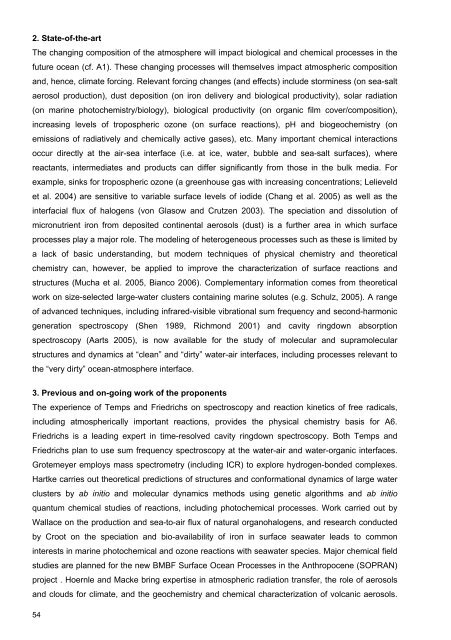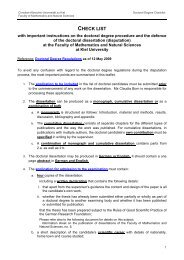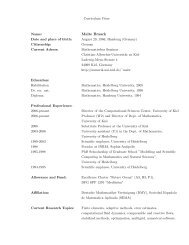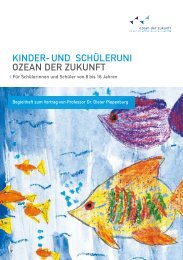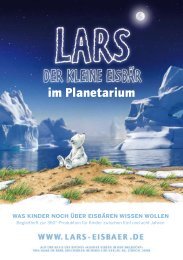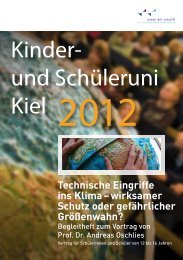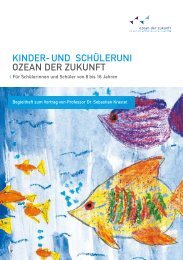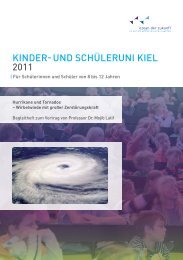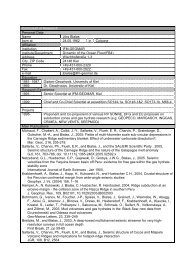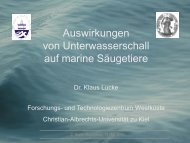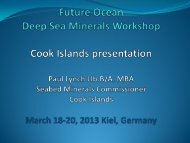Untitled - The Future Ocean
Untitled - The Future Ocean
Untitled - The Future Ocean
- No tags were found...
Create successful ePaper yourself
Turn your PDF publications into a flip-book with our unique Google optimized e-Paper software.
2. State-of-the-art<strong>The</strong> changing composition of the atmosphere will impact biological and chemical processes in thefuture ocean (cf. A1). <strong>The</strong>se changing processes will themselves impact atmospheric compositionand, hence, climate forcing. Relevant forcing changes (and effects) include storminess (on sea-saltaerosol production), dust deposition (on iron delivery and biological productivity), solar radiation(on marine photochemistry/biology), biological productivity (on organic film cover/composition),increasing levels of tropospheric ozone (on surface reactions), pH and biogeochemistry (onemissions of radiatively and chemically active gases), etc. Many important chemical interactionsoccur directly at the air-sea interface (i.e. at ice, water, bubble and sea-salt surfaces), wherereactants, intermediates and products can differ significantly from those in the bulk media. Forexample, sinks for tropospheric ozone (a greenhouse gas with increasing concentrations; Lelieveldet al. 2004) are sensitive to variable surface levels of iodide (Chang et al. 2005) as well as theinterfacial flux of halogens (von Glasow and Crutzen 2003). <strong>The</strong> speciation and dissolution ofmicronutrient iron from deposited continental aerosols (dust) is a further area in which surfaceprocesses play a major role. <strong>The</strong> modeling of heterogeneous processes such as these is limited bya lack of basic understanding, but modern techniques of physical chemistry and theoreticalchemistry can, however, be applied to improve the characterization of surface reactions andstructures (Mucha et al. 2005, Bianco 2006). Complementary information comes from theoreticalwork on size-selected large-water clusters containing marine solutes (e.g. Schulz, 2005). A rangeof advanced techniques, including infrared-visible vibrational sum frequency and second-harmonicgeneration spectroscopy (Shen 1989, Richmond 2001) and cavity ringdown absorptionspectroscopy (Aarts 2005), is now available for the study of molecular and supramolecularstructures and dynamics at “clean” and “dirty” water-air interfaces, including processes relevant tothe “very dirty” ocean-atmosphere interface.3. Previous and on-going work of the proponents<strong>The</strong> experience of Temps and Friedrichs on spectroscopy and reaction kinetics of free radicals,including atmospherically important reactions, provides the physical chemistry basis for A6.Friedrichs is a leading expert in time-resolved cavity ringdown spectroscopy. Both Temps andFriedrichs plan to use sum frequency spectroscopy at the water-air and water-organic interfaces.Grotemeyer employs mass spectrometry (including ICR) to explore hydrogen-bonded complexes.Hartke carries out theoretical predictions of structures and conformational dynamics of large waterclusters by ab initio and molecular dynamics methods using genetic algorithms and ab initioquantum chemical studies of reactions, including photochemical processes. Work carried out byWallace on the production and sea-to-air flux of natural organohalogens, and research conductedby Croot on the speciation and bio-availability of iron in surface seawater leads to commoninterests in marine photochemical and ozone reactions with seawater species. Major chemical fieldstudies are planned for the new BMBF Surface <strong>Ocean</strong> Processes in the Anthropocene (SOPRAN)project . Hoernle and Macke bring expertise in atmospheric radiation transfer, the role of aerosolsand clouds for climate, and the geochemistry and chemical characterization of volcanic aerosols.54


